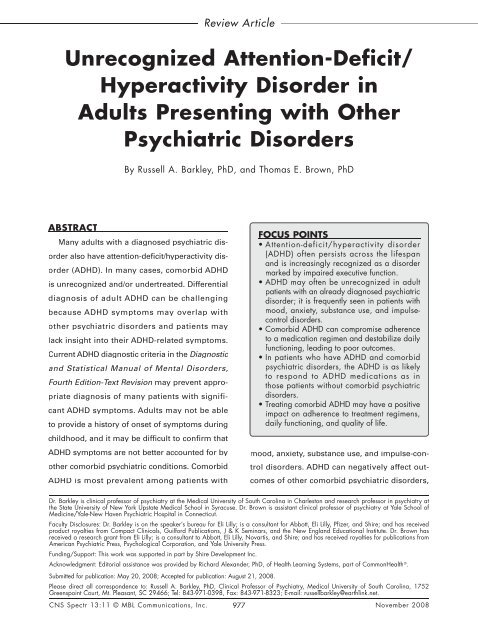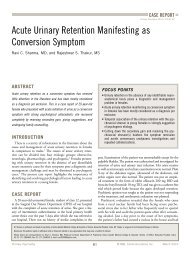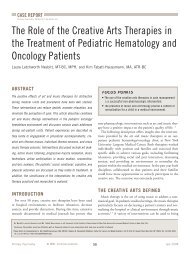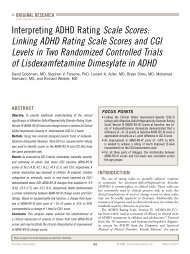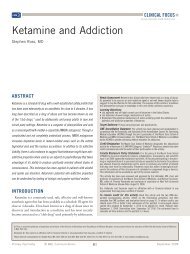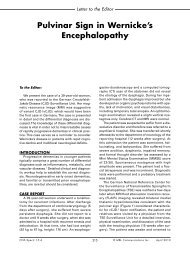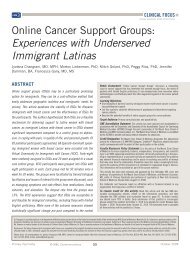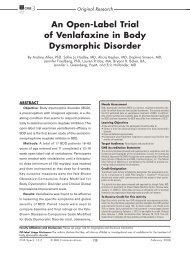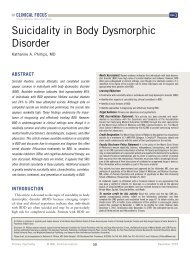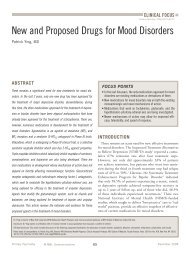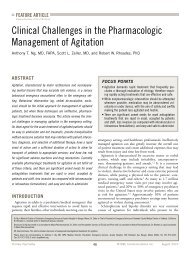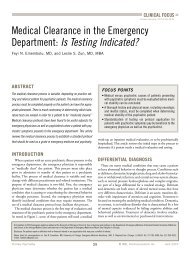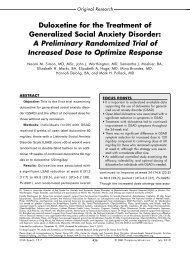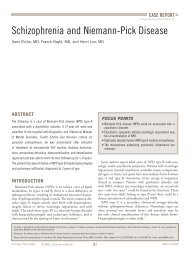Unrecognized Attention-Deficit/ Hyperactivity Disorder In - MBL ...
Unrecognized Attention-Deficit/ Hyperactivity Disorder In - MBL ...
Unrecognized Attention-Deficit/ Hyperactivity Disorder In - MBL ...
You also want an ePaper? Increase the reach of your titles
YUMPU automatically turns print PDFs into web optimized ePapers that Google loves.
Review Article<br />
<strong>Unrecognized</strong> <strong>Attention</strong>-<strong>Deficit</strong>/<br />
<strong>Hyperactivity</strong> <strong>Disorder</strong> in<br />
Adults Presenting with Other<br />
Psychiatric <strong>Disorder</strong>s<br />
ABSTRACT<br />
By Russell A. Barkley, PhD, and Thomas E. Brown, PhD<br />
Many adults with a diagnosed psychiatric dis-<br />
order also have attention-deficit/hyperactivity dis-<br />
order (ADHD). <strong>In</strong> many cases, comorbid ADHD<br />
is unrecognized and/or undertreated. Differential<br />
diagnosis of adult ADHD can be challenging<br />
because ADHD symptoms may overlap with<br />
other psychiatric disorders and patients may<br />
lack insight into their ADHD-related symptoms.<br />
Current ADHD diagnostic criteria in the Diagnostic<br />
and Statistical Manual of Mental <strong>Disorder</strong>s,<br />
Fourth Edition-Text Revision may prevent appro-<br />
priate diagnosis of many patients with signifi-<br />
cant ADHD symptoms. Adults may not be able<br />
to provide a history of onset of symptoms during<br />
childhood, and it may be difficult to confirm that<br />
ADHD symptoms are not better accounted for by<br />
other comorbid psychiatric conditions. Comorbid<br />
ADHD is most prevalent among patients with<br />
Dr. Barkley is clinical professor of psychiatry at the Medical University of South Carolina in Charleston and research professor in psychiatry at<br />
the State State University University of of New New York York Upstate Upstate Medical Medical School School in in Syracuse. Syracuse. Dr. Dr. Brown Brown is is assistant assistant clinical clinical professor professor of of psychiatry<br />
psychiatry at Yale School of<br />
Medicine/Yale-New Haven Psychiatric Hospital in Connecticut.<br />
Faculty Disclosures: Dr. Barkley is on the speaker’s bureau for Eli Lilly; is a consultant for Abbott, Eli Lilly, Pfizer, and Shire; and has received<br />
product royalties royalties from from Compact Compact Clinicals, Clinicals, Guilford Guilford Publications, Publications, J J & & K K Seminars, Seminars, and and the the New New England England Educational Educational <strong>In</strong>stitute. <strong>In</strong>stitute. Dr. Dr. Brown has<br />
received a research grant from Eli Lilly; is a consultant to Abbott, Eli Lilly, Novartis, and Shire; and has received royalties for publications from<br />
American Psychiatric Press, Psychological Corporation, and Yale University Press.<br />
Funding/Support: This work was supported in part by Shire Development <strong>In</strong>c.<br />
Acknowledgment: Editorial assistance was provided by Richard Alexander, PhD, of Health Learning Systems, part of CommonHealth ® .<br />
Submitted for publication: May 20, 2008; Accepted for publication: August 21, 2008.<br />
FOCUS POINTS<br />
• <strong>Attention</strong>-deficit/hyperactivity disorder<br />
(ADHD) often persists across the lifespan<br />
and is increasingly recognized as a disorder<br />
marked by impaired executive function.<br />
• ADHD may often be unrecognized in adult<br />
patients with an already diagnosed psychiatric<br />
disorder; it is frequently seen in patients with<br />
mood, anxiety, substance use, and impulsecontrol<br />
disorders.<br />
• Comorbid ADHD can compromise adherence<br />
to a medication regimen and destabilize daily<br />
functioning, leading to poor outcomes.<br />
• <strong>In</strong> patients who have ADHD and comorbid<br />
psychiatric disorders, the ADHD is as likely<br />
to respond to ADHD medications as in<br />
those patients without comorbid psychiatric<br />
disorders.<br />
• Treating comorbid ADHD may have a positive<br />
impact on adherence to treatment regimens,<br />
daily functioning, and quality of life.<br />
mood, anxiety, substance use, and impulse-con-<br />
trol disorders. ADHD can negatively affect out-<br />
comes of other comorbid psychiatric disorders,<br />
Please direct all correspondence to: Russell A. Barkley, PhD, Clinical Professor of Psychiatry, Medical University of South Carolina, 1752<br />
Greenspoint Court, Mt. Pleasant, SC 29466; Tel: 843-971-0398, Fax: 843-971-8323; E-mail: russellbarkley@earthlink.net.<br />
CNS Spectr 13:11 © <strong>MBL</strong> Communications, <strong>In</strong>c. 977<br />
November 2008
and ADHD symptoms may compromise com-<br />
pliance with treatment regimens. Furthermore,<br />
unrecognized ADHD symptoms may be mistaken<br />
for poor treatment response in these comorbid<br />
disorders. <strong>In</strong> these individuals, ADHD pharmaco-<br />
therapy seems to be as effective in reducing core<br />
ADHD symptoms, as it is in patients who have no<br />
comorbidity. Limited evidence further suggests<br />
that ADHD therapy may help to improve symp-<br />
toms of certain psychiatric comorbidities, such<br />
as depression. Therefore, management of ADHD<br />
may help to stabilize daily functioning and facili-<br />
tate a fuller recovery.<br />
CNS Spectr. Spectr 2008;13(11):977-984<br />
INTRODUCTION<br />
<strong>Attention</strong>-deficit/hyperactivity disorder (ADHD),<br />
which had been considered as a disorder limited<br />
primarily to childhood, is now regarded as a<br />
persistent neurodevelopmental disorder impairing<br />
executive functioning (EF), or the “management<br />
system” of the brain, that usually persists<br />
into adulthood. 1,2 ADHD is estimated to affect<br />
as many as 5% to 12% of children worldwide, 3-5<br />
with ~15% to 65% of these showing persistence<br />
of ADHD symptoms into adulthood. 6 This range<br />
is largely due to the definition of persistence,<br />
which includes individuals with partial remission.<br />
Overall, ADHD is estimated to affect 4.4%<br />
of adults in the United States, 7 but it frequently<br />
remains undiagnosed, with ~10.9% of eligible<br />
patients currently receiving treatment. 7<br />
One reason that ADHD in adults is not adequately<br />
treated is that it may not be recognized. Patients<br />
may have symptoms that do not fit those traditionally<br />
associated with ADHD, or their ADHD symptoms<br />
may be seen as aspects of another diagnosed<br />
psychiatric disorder. 8 For example, some symptoms<br />
of ADHD may be mistaken for symptoms of other<br />
disorders (ie, bipolar depression, anxiety disorder).<br />
Some other symptoms may not be in the Diagnostic<br />
and Statistical Manual of Mental <strong>Disorder</strong>s, Fourth<br />
Edition, Text Revision 1 (eg, problems with executive<br />
function), while some are separate disorders that<br />
have increased risk when one is diagnosed with<br />
ADHD (eg, substance use). 9<br />
Patients may also lack insight into their problems<br />
and assume that their ADHD symptoms are person-<br />
Review Article<br />
ality or character traits. They may not understand<br />
the manner in which ADHD symptoms appear in<br />
an adult. For these or other reasons, patients may<br />
fail to mention ADHD symptoms to their healthcare<br />
provider unless they are specifically asked.<br />
<strong>In</strong> a sample of individuals in the US diagnosed<br />
with any psychiatric disorder within the preceding<br />
12 months, between 6.5% and 25.4% also<br />
met criteria for adult ADHD (Figure). 7,10,11 The<br />
four most prevalent psychiatric disorders linked<br />
to elevated rates of comorbid ADHD include<br />
drug dependence, agoraphobia, dysthymia, and<br />
bipolar disorder. 7,11 Given these high rates of<br />
comorbidity, clinicians should routinely screen<br />
for ADHD in every diagnostic evaluation.<br />
The possibility of comorbid ADHD should be<br />
considered during the course of treatment when<br />
a patient does not respond adequately to the<br />
usual interventions for a diagnosed disorder.<br />
Nonresponse may be due to noncompliance,<br />
which may be associated with ADHD. 12 Patients<br />
with ADHD may be forgetful or too impulsive<br />
to be compliant with a regular treatment regimen<br />
for their comorbid disorder. They may also<br />
become dissatisfied because of a perceived lack<br />
of improvement in their symptoms and decide to<br />
stop the treatment. Partial response, refractory<br />
symptoms, or patient noncompliance may be<br />
related to the presence of unrecognized ADHD.<br />
FIGURE.<br />
Prevalence of adult ADHD among<br />
National Comorbidity Survey replication<br />
respondents (N=3,199) with a<br />
psychiatric disorder 7<br />
Dysthymia<br />
Bipolar disorder<br />
Any mood disorder<br />
GAD<br />
PTSD<br />
Panic disorder<br />
Agorophobia<br />
Specific phobia<br />
Social phobia<br />
OCD<br />
Any anxiety disorder<br />
Alcohol abuse<br />
Alcohol dependence<br />
Drug abuse<br />
Drug dependence<br />
Any substance use disorder<br />
<strong>In</strong>termittent explosive disorder<br />
0 10 20 30<br />
With ADHD (%)<br />
Reprinted with permission from the Am J Psychiatry, Copyright 2006.<br />
American Psychiatric Association.<br />
ADHD=attention-deficit/hyperactivity disorder; GAD=generalized anxiety disorder;<br />
PTSD=posttraumatic stress disorder; OCD=obsessive-compulsive disorder.<br />
Barkley RA, Brown TE. CNS Spectr. Spectr Vol 13, No 11. 2008.<br />
CNS Spectr 13:11 © <strong>MBL</strong> Communications, <strong>In</strong>c. 978<br />
November 2008<br />
Primary Diagnosis
Proper recognition and treatment of comorbid<br />
ADHD may help patients better adhere to treatment<br />
regimens and may resolve refractory symptoms,<br />
boosting therapeutic benefits and enhancing<br />
quality of life. However, appropriate treatment of<br />
comorbid ADHD is often not provided.<br />
TABLE.<br />
Proposed DSM-V Criteria for ADHD in<br />
Adults 1<br />
Six (or more) of the following symptoms persisting for<br />
at least 6 months to a degree that is maladaptive and<br />
developmentally inappropriate<br />
1. Often easily distracted by extraneous stimuli or irrelevant<br />
thoughts<br />
2. Often makes decisions impulsively<br />
3. Often has difficulty stopping activities or behaviors<br />
when they should do so<br />
4. Often starts a project or task without reading or listening<br />
to the directions carefully<br />
5. Often shows poor follow-through on promises or<br />
commitments made to others<br />
6. Often has trouble doing things in their proper order<br />
or sequence<br />
7. Often more likely to drive a motor vehicle much<br />
faster than others (excessive speeding)<br />
Alternate symptom for adults with no driving experience:<br />
often has difficulty engaging in leisure activities<br />
or doing fun things quietly<br />
8. Often has difficulty sustaining attention in tasks or<br />
play activities<br />
9. Often has difficulty organizing tasks and activities<br />
• Some symptoms that caused impairment were present<br />
in childhood to adolescence (before 16 years of age)<br />
• Some impairment from the symptoms is present in >2<br />
settings (eg, work, educational settings, home life, community<br />
functioning, social relationships)<br />
• There is clear evidence of clinically significant impairment<br />
in social, educational, domestic (eg, dating, marriage,<br />
cohabitation, financial, driving, childrearing),<br />
occupational, or community functioning<br />
• The symptoms do not occur exclusively during the<br />
course of a pervasive developmental disorder, schizophrenia,<br />
or other psychiatric disorder, and are not<br />
better accounted for by another mental disorder (eg,<br />
mood disorder, anxiety disorder, dissociative disorder,<br />
a personality disorder)<br />
DSM-V= DSM-V Diagnostic and Statistical Manual of Mental <strong>Disorder</strong>s, Fifth<br />
Edition; ADHD=attention-deficit/hyperactivity disorder.<br />
ADHD in Adults: What the Science Tells Us. Copyright 2008 Guilford Press.<br />
Reprinted with permission of The Guilford Press.<br />
Barkley RA, Brown TE. CNS Spectr. Spectr<br />
Vol 13, No 11. 2008.<br />
Review Article<br />
KEY FACTORS FOR DIAGNOSING<br />
COMORBID ADHD IN ADULTS<br />
Diagnostic Criteria and Symptom<br />
Presentation for Adult ADHD<br />
Clinicians should be familiar with the various<br />
presentations of ADHD in adults. 1 Clinicians should<br />
also be aware that the DSM-IV-TR requirement<br />
that adult patients have onset of ADHD symptoms<br />
before 7 years of age is being reexamined and<br />
questioned. 13-16 Adults who meet all DSM-IV-TR<br />
ADHD symptom criteria except for the stipulation<br />
that onset of symptoms should be before 7<br />
years of age, have been found not to differ significantly<br />
from adults with the stipulated early<br />
age of onset. 17 ADHD often is not recognized until<br />
adolescence or early adulthood, when EFs are<br />
challenged by increased demands for self-management.<br />
Females and males who are intelligent<br />
and do not exhibit disruptive behavior in early<br />
childhood are especially likely to have their ADHD<br />
symptoms overlooked until mid-adolescence or<br />
early adulthood. 13 Therefore, since symptoms may<br />
be overlooked until later in life, diagnosis of ADHD<br />
in adults should be made as early as possible,<br />
with no predefined age limit for onset of symptoms<br />
in childhood and adolescence.<br />
Broadly considered, EF is a set of cognitive processes,<br />
including attention, that facilitate flexible,<br />
goal-directed behaviors. 18 Barkley and colleagues1 consider these EFs to be forms of self-directed<br />
actions used to modify subsequent behavior so as<br />
to maximize longer-term or delayed consequences.<br />
The primary components or clusters of EF include<br />
behavioral inhibition; organizing and activating to<br />
work; sustaining and shifting attention to tasks;<br />
regulating alertness and sustaining effort; managing<br />
emotions; and using working memory. 2 EF<br />
impairments in adults may appear as distractibility<br />
or problems with organization and time management,<br />
and may affect academic or professional<br />
performance as well as personal life.<br />
Manifestations of ADHD symptoms may<br />
change considerably from childhood to adulthood.<br />
Although hyperactivity is not required for<br />
a diagnosis of ADHD, 16 when present, it tends to<br />
diminish with age, 19 so those with ADHD may not<br />
show symptoms of hyperactivity in adulthood,<br />
even though they had such symptoms in early<br />
childhood. 20,21 The set of symptoms associated<br />
with inattention usually become more prominent<br />
in adults with ADHD. Adults with ADHD are<br />
less likely to obtain college or advanced degrees<br />
CNS Spectr 13:11 © <strong>MBL</strong> Communications, <strong>In</strong>c. 979<br />
November 2008
and more likely to experience employment<br />
instability marked by frequent job changes. 22,23<br />
Furthermore, adults who had childhood ADHD<br />
are more likely to have poor driving records, 24,25<br />
marital difficulties, and fewer friends. 23,25<br />
Not all EF impairments are attributable to<br />
ADHD. 26 Such difficulties can also result from<br />
substance abuse, disorders on the autistic spectrum,<br />
cerebral vascular accidents, dementias,<br />
etc. Skilled clinical evaluation in assessing longterm<br />
functioning across multiple domains is<br />
needed to accurately differentiate ADHD from<br />
other psychiatric and neurologic disorders.<br />
Comprehensive clinical interviews are an<br />
effective way to assess for ADHD and to make an<br />
adequate differential diagnosis. EF deficits may<br />
underlie reported inability to start or complete<br />
projects; thus, chronic and severe procrastination<br />
is often a major problem. 2 Adults with ADHD<br />
may cite problems sustaining attention during<br />
classes or meetings, or report losing track of a<br />
discussion because of daydreaming or becoming<br />
drowsy, despite actively trying to pay atten-<br />
tion. Adults with ADHD may also have difficulty<br />
controlling emotions, feeling overwhelmed, sad,<br />
impatient, or angry, often over minor issues and<br />
may act out in ways inappropriate or disproportionate<br />
to the situation. 2<br />
Physicians may expect impairments across<br />
all aspects of ADHD, but some adults may mask<br />
some of their ADHD symptoms through use of<br />
minimizing or compensating strategies. For example,<br />
they may choose professions involving much<br />
physical activity or avoid situations demanding<br />
long periods of intense concentration. 27<br />
One common mistake in assessment is failure<br />
to recognize that adults with ADHD may show<br />
normal or excellent functioning while doing tasks<br />
in which they have strong personal interest or<br />
when they feel themselves under threat of immediate<br />
negative consequences if they fail to complete<br />
the task immediately. The patient with ADHD<br />
typically cannot utilize willpower to achieve comparable<br />
levels of efficacy in situations that are not<br />
of high interest or of immediate threat. 2,13<br />
Diagnostic Approaches and Tools<br />
Traditional neuropsychological tests to evaluate<br />
EF are of limited use in diagnosing adults with<br />
suspected ADHD. 26,28 A meta-analysis of 33 investigations<br />
using traditional EF assessments found<br />
inconsistencies and a wide variety of performance<br />
differences that indicate neuropsychological defi-<br />
Review Article<br />
cits in adults with ADHD. 29 The complex and interactive<br />
nature of EF suggests that more sensitive<br />
assessments are derived from clinical interviews<br />
assessing how the patient performs complex,<br />
self-managed tasks of everyday life. 30<br />
While clinically useful, DSM-IV-TR criteria have<br />
important limitations for adults. They have been<br />
developed and validated only for children 4–17<br />
years of age. Consequently, some items lack relevance<br />
in adults (eg, “has difficulty playing...<br />
quietly”). Further, the threshold requirement for<br />
6 of 9 possible symptoms on one or both of two<br />
clusters of diagnostic criteria, or 3.5 standard<br />
deviations above the mean for a normal control<br />
group, 31 appears overly restrictive for diagnosing<br />
adult ADHD. Because of these limitations, the<br />
DSM-IV-TR criteria may miss many adult ADHD<br />
patients with significant impairments. 15<br />
To evaluate possible ADHD in adults, the<br />
ADHD Rating Scale IV (ADHD-RS-IV), 32 based on<br />
the 18 symptoms in the DSM-IV-TR, has been<br />
modified with additional prompts for adults. 33<br />
The adult prompts include changing some of<br />
the wording in the questions of the ADHD-RS-<br />
IV. For example, the phrase “play activities”<br />
might be replaced with “leisure activities” in<br />
the item “has difficulty sustaining attention in<br />
tasks or play activities.” 33<br />
Two criteria-normed symptom rating scales<br />
for adults (Conners’ Adult ADHD Rating Scale<br />
[CAARS], Brown <strong>Attention</strong>-<strong>Deficit</strong> <strong>Disorder</strong><br />
Scale [BADDS]) that elicit self-report and collateral<br />
report data on a range of ADHD-related<br />
symptoms more inclusive than the DSM-IV-TR<br />
diagnostic criteria have been published. Kooij<br />
and colleagues 34 recently compared these<br />
scales with one another and with the ADHD-<br />
RS in conjunction with a structured diagnostic<br />
interview. <strong>In</strong> a sample of 120 adults with<br />
ADHD, the CAARS had a missed diagnosis rate<br />
of 39%, while the ADHD-RS (9% to 20% missed<br />
diagnosis depending on cutoff), and BAADS<br />
(16% missed diagnosis) performed better in<br />
predicting clinical diagnosis. They also found<br />
that adults with ADHD seem to be the best<br />
informants regarding their symptoms, though<br />
patients did underreport inattention and hyperactivity/impulsivity<br />
on the ADHD-RS. 34<br />
Barkley and colleagues 1 have proposed a<br />
revised list of ADHD symptoms in adults for possible<br />
inclusion in the upcoming DSM-V. DSM-V A chart<br />
review of >200 adults with a DSM-IV-TR diag-<br />
nosis of ADHD yielded 91 common complaints<br />
CNS Spectr 13:11 © <strong>MBL</strong> Communications, <strong>In</strong>c. 980<br />
November 2008
and adaptive behavioral difficulties, including 9<br />
items related to cognitive and behavioral inhibition<br />
(Table). 1 The presence of 6 of these 9 items<br />
accurately classified 92% of adults with DSM-<br />
IV-TR–diagnosed ADHD while excluding 99%<br />
of healthy controls. 1 The items on the new list<br />
emphasize distractibility, impulsiveness, poor<br />
concentration, inability to persist at tasks, and<br />
difficulties with working memory, organization,<br />
and planning.<br />
INCIDENCE OF COMORBID ADHD IN<br />
PATIENTS WITH OTHER PSYCHIATRIC<br />
DISORDERS<br />
The National Comorbidity Survey reported<br />
that about 4.4% of adults 18–44 years of age were<br />
found to meet diagnostic criteria for ADHD that<br />
include DSM-IV-TR criteria, symptom onset prior<br />
to 7 years of age, and impairment in at least two<br />
areas of living during the preceding 6 months. 7<br />
Patients with DSM-IV-TR–defined DSM-IV-TR mood, anxiety,<br />
substance use, and impulse control disorders<br />
have high rates of ADHD. 7,35,36 For example,<br />
ADHD was highly prevalent among individuals<br />
with drug dependence (25.4%), bipolar disorder<br />
(21.2%), dysthymia (22.6%), and agoraphobia<br />
(19.1%) (Figure), though it was not as prevalent<br />
among individuals with drug abuse (7.2%) or<br />
obsessive-compulsive disorder (6.5%). The overall<br />
prevalence of ADHD was 2- to 7-fold higher in<br />
those with psychiatric conditions. 7<br />
Depression<br />
Estimates of ADHD among patients with major<br />
depressive disorder (MDD) vary widely, depending<br />
on the sampling and the methodologies<br />
used. Greater than 16.0% of MDD patients in one<br />
clinical study met full or partial lifetime criteria<br />
for ADHD, 37 while in another study, 38 42.5% of<br />
those with recurrent brief depression met criteria<br />
for ADHD. A large community-based survey<br />
identified ADHD in 9.4% of respondents with<br />
MDD, while the presence of ADHD was 3.7% in<br />
those without MDD. 7 An analysis based on health<br />
insurance claims, however, found that only 0.2%<br />
of adults (454 of 17,792) with a coded diagnosis<br />
of MDD were diagnosed with ADHD. 39 Another<br />
claims analysis found ADHD in 1.7% of patients<br />
whose primary diagnoses were MDD and an anxiety<br />
disorder. 40 Such discrepancies suggest that<br />
in clinical practice, where diagnosis may depend<br />
on patient-defined complaints, comorbid ADHD<br />
may often go undetected in patients with MDD.<br />
Review Article<br />
Depressed individuals with and without ADHD<br />
appear to have similar age of onset of MDD; similar<br />
number, duration, and severity of episodes;<br />
and comparable response to antidepressant<br />
treatment. 37 However, MDD patients with comorbid<br />
ADHD more frequently seek psychotherapy<br />
and/or pharmacotherapy, and have higher frequencies<br />
of social phobia and generalized anxiety<br />
disorder than patients with ADHD alone. 41<br />
Bipolar <strong>Disorder</strong><br />
Bipolar disorder—with a lifetime prevalence<br />
of 3.9% in the US—is also highly prevalent in<br />
patients with ADHD. 42 <strong>In</strong> one study, 43 bipolar<br />
disorder was detected at baseline in 11.0% of<br />
boys with ADHD; 4 years later, new cases of<br />
bipolar disorder had been diagnosed in an additional<br />
12.0%. <strong>In</strong> addition, 21.2% of adults with<br />
bipolar disorder also met criteria for ADHD. 7<br />
<strong>In</strong> subjects with bipolar disorder, the lifetime<br />
presence of ADHD was higher in men than in<br />
women (14.7% vs 5.8%, respectively). 11 The<br />
course of bipolar disease in individuals with<br />
comorbid ADHD is marked by earlier onset<br />
(mean: 12.1 vs 20.0 years) 44 and more frequent<br />
affective episodes, suicide attempts, violence,<br />
and legal problems. 11 It is important to recognize<br />
that these mood disorders occur in ADHD<br />
as well as in other psychiatric disorders, and<br />
that simply having a mood disorder does not<br />
preclude a diagnosis of ADHD. 7<br />
Substance Use <strong>Disorder</strong>s<br />
Patients with substance use disorders (SUDs)<br />
are more likely to have a previous or current<br />
diagnosis of ADHD. <strong>In</strong> respondents with any<br />
SUD, 10.8% met criteria for comorbid ADHD. 7<br />
While ADHD was more prevalent among individuals<br />
with alcohol abuse (9.5%), alcohol<br />
dependence (11.1%), and drug abuse (7.2%)<br />
than in those without these comorbidities (4.0%,<br />
4.0%, and 4.1%, respectively), these differences<br />
were not significant. However, drug-dependent<br />
individuals were significantly more likely to<br />
have ADHD (25.4% vs 4.0% of those without<br />
any other psychiatric disorder). ADHD is also<br />
more prevalent among patients who undergo<br />
voluntary treatment for an SUD. <strong>In</strong> a study of<br />
adults admitted to chemical dependency treatment<br />
centers, 24.0% met DSM-IV-TR criteria for<br />
adult ADHD, 45 and 34.0% of adolescents being<br />
treated for SUDs had a lifetime diagnosis of<br />
ADHD. 46 <strong>In</strong> a study of adults treated for cocaine<br />
CNS Spectr 13:11 © <strong>MBL</strong> Communications, <strong>In</strong>c. 981<br />
November 2008
addiction, 35% had ADHD. 47 The course of SUDs<br />
in the presence of comorbid ADHD may also<br />
be more severe. Despite greater involvement<br />
with addiction treatment, these patients are less<br />
likely to abstain from drugs. 47<br />
A patient’s specific ADHD symptomatology<br />
may affect the risk of SUDs. 48 Severe symptoms<br />
of hyperactivity and impulsivity during childhood<br />
and adulthood seem to be predictive of<br />
later cocaine abuse, whereas inattentive symptoms<br />
are not. 49 However, recent findings demonstrated<br />
that stimulant treatment of children and<br />
adolescents with ADHD does not increase their<br />
risk of SUDs in adulthood and may offer additional<br />
benefits. 50<br />
Anxiety <strong>Disorder</strong>s<br />
The prevalence of ADHD is significantly higher<br />
in patients with most anxiety disorders. 7 One<br />
study of children found that 19.1% of patients<br />
with agoraphobia, 14.0% with social phobia, and<br />
13.4% with posttraumatic stress disorder (PTSD)<br />
met criteria for ADHD. Moreover, cognitive and<br />
academic vulnerabilities were greater in patients<br />
with an anxiety disorder and ADHD than in those<br />
with an anxiety disorder alone. 51<br />
Conduct <strong>Disorder</strong> and/or Oppositional<br />
Defiant <strong>Disorder</strong><br />
The lifetime prevalence of conduct disorder<br />
(CD) and oppositional defiant disorder (ODD)<br />
among US adults has been estimated at 9.5%<br />
and 8.5%, respectively. 42 Their lifetime prevalence<br />
is increased among children and adults<br />
with ADHD. Of children and adolescents with<br />
ADHD, 40% to 60% also met criteria for ODD or,<br />
less often, CD. 52,53 Furthermore, 24% to 35% of<br />
clinically referred adults with ADHD have ODD<br />
and up to 25% have CD. 9,36 <strong>In</strong> children with ADHD<br />
and CD, antisocial personality disorder is often<br />
seen as an adult outcome, present in 7% to 44%<br />
of adults with ADHD. 9<br />
CD, antisocial personality disorder, and<br />
ADHD are associated with heightened risks<br />
for SUDs. 9,45,54 <strong>In</strong> children with ADHD followed<br />
through adolescence, those with ongoing CD<br />
were significantly more likely to be diagnosed<br />
with an SUD (30% vs 6%; P
as ADHD, have not been as thoroughly developed<br />
for diagnosis in adults as they have for<br />
diagnosis in children, yet comorbid ADHD generally<br />
increases overall disease burden, with<br />
more severe involvement and greater functional<br />
impairment. Symptoms of comorbid psychiatric<br />
disorders that persist or respond poorly to therapy<br />
may be due to undiagnosed and untreated<br />
ADHD. More research is warranted to quantify<br />
the rates of undiagnosed ADHD within patients<br />
already being treated for other psychiatric disorders.<br />
ADHD may also compromise patient satisfaction<br />
with, and adherence to, treatment of<br />
their comorbid psychiatric disorders. Successful<br />
treatment of the comorbid condition in some<br />
patients may not be achieved until ADHD is adequately<br />
managed. Specific interventions for the<br />
treatment of ADHD will be determined by which<br />
comorbid psychiatric disorders are present.<br />
Accurate diagnosis and effective treatment of<br />
ADHD has a positive impact on patient quality<br />
of life. <strong>In</strong>itiation of ADHD treatment may resolve<br />
refractory symptoms. Patients may be more<br />
compliant with medication, resolving functional<br />
impairments related to ADHD. This creates a background<br />
of stable functioning from which recovery<br />
from other disorders may be facilitated. CNS<br />
REFERENCES<br />
1. Barkley RA, Murphy KR, Fischer M. Identifying new symptoms for ADHD in adulthood. <strong>In</strong>:<br />
ADHD in Adults: What the Science Tells Us. New York, NY: Guilford Press; 2008:170-204.<br />
2. Brown T. <strong>Attention</strong> <strong>Deficit</strong> <strong>Disorder</strong>: The Unfocused Mind in Children and Adults.<br />
New Haven, CT: Yale University Press; 2005.<br />
3. Biederman J, Faraone SV. <strong>Attention</strong>-deficit hyperactivity disorder. Lancet. Lancet<br />
2005;366:237-248.<br />
4. Polanczyk G, de Lima MS, Horta BL, Biederman J, Rohde LA. The worldwide prevalence<br />
of ADHD: a systematic review and metaregression analysis. Am J Psychiatry. Psychiatry<br />
2007;164:942-948.<br />
5. Faraone SV, Sergeant J, Gillberg C, Biederman J. The worldwide prevalence of<br />
ADHD: is it an American condition? World Psychiatry. 2003;2:104-113.<br />
6. Faraone SV, Biederman J, Mick E. The age-dependent decline of attention deficit<br />
hyperactivity disorder: a meta-analysis of follow-up studies. Psychol Med. Med<br />
2006;36:159-165.<br />
7. Kessler RC, Adler L, Barkley R, et al. The prevalence and correlates of adult ADHD<br />
in the United States: results from the National Comorbidity Survey Replication.<br />
Am J Psychiatry. Psychiatry 2006;163:716-723.<br />
8. Milberger S, Biederman J, Faraone SV, Murphy J, Tsuang MT. <strong>Attention</strong> deficit<br />
hyperactivity disorder and comorbid disorders: issues of overlapping symptoms.<br />
Am J Psychiatry. Psychiatry 1995;152:1793-1799.<br />
9. Barkley RA, Murphy KR, Fischer M. Comorbid psychiatric disorders and psychological<br />
maladjustment. <strong>In</strong>: ADHD in Adults: What the Science Tells Us. New York, NY:<br />
Guilford Press; 2008;205-244.<br />
10. Robison LM, Skaer TL, Sclar DA. Is attention-deficit hyperactivity disorder (ADHD)<br />
diagnosed in adults? An examination of US office-based physician visits, 1995-<br />
2000. <strong>In</strong>t J Pharm Med. Med 2004;18:337-341.<br />
11. Nierenberg AA, Miyahara S, Spencer T, et al, for STEP-DB <strong>In</strong>vestigators. Clinical<br />
and diagnostic implications of lifetime attention-deficit/hyperactivity disorder<br />
comorbidity in adults with bipolar disorder: data from the first 1000 STEP-BD participants.<br />
Biol Psychiatry. Psychiatry 2005;57:1467-1473.<br />
12. Steinhoff KW. <strong>Attention</strong>-deficit/hyperactivity disorder: medication treatment-dosing<br />
and duration of action. Am J Manag Care. 2004;10:S99-S106.<br />
13. Brown TE. DSM-IV: ADHD and executive function impairments. Adv Stud Med. Med<br />
2002;2:910-914.<br />
Review Article<br />
14. Barkley RA, Biederman J. Toward a broader definition of the age-of-onset criterion<br />
for attention-deficit hyperactivity disorder. J Am Acad Child Adolesc Psychiatry. Psychiatry<br />
1997;36:1204-1210.<br />
15. Barkley RA, Murphy KR, Fischer M. Diagnostic criteria for ADHD in adults. <strong>In</strong>: ADHD<br />
in Adults: What the Science Tells Us. New York, NY: Guilford Press; 2008:26-40.<br />
16. <strong>Disorder</strong>s usually first diagnosed in infancy, childhood, or adolescence. Diagnostic<br />
and Statistical Manual of Mental <strong>Disorder</strong>s. 4th ed. text rev. Washington, DC:<br />
American Psychiatric Association. 2000;85-102.<br />
17. Faraone SV, Biederman J, Spencer T, et al. Diagnosing adult attention deficit hyperactivity<br />
disorder: are late onset and subthreshold diagnoses valid? Am J Psychiatry. Psychiatry<br />
2006;163:1720-1729.<br />
18. Castellanos FX, Sonuga-Barke EJ, Milham MP, Tannock R. Characterizing cognition<br />
in ADHD: beyond executive dysfunction. Trends Cogn Sci. Sci 2006;10:117-123.<br />
19. Biederman J, Mick E, Faraone SV. Age-dependent decline of symptoms of attention<br />
deficit hyperactivity disorder: impact of remission definition and symptom type. Am<br />
J Psychiatry. Psychiatry 2000;157:816-818.<br />
20. Stavro GM, Ettenhofer ML, Nigg JT. Executive functions and adaptive functioning in young<br />
adult attention-deficit/hyperactivity disorder. J <strong>In</strong>t Neuropsychol Soc. 2007;13:324-334.<br />
21. Hart EL, Lahey BB, Loeber R, Applegate B, Frick PJ. Developmental change in attention-deficit<br />
hyperactivity disorder in boys: a four-year longitudinal study. J Abnorm<br />
Child Psychol. 1995;23:729-749.<br />
22. Biederman J, Faraone SV. The effects of attention-deficit/hyperactivity disorder on<br />
employment and household income. MedGenMed. MedGenMed 2006;8:12.<br />
23. Barkley RA, Fischer M, Smallish L, Fletcher K. Young adult outcome of hyperactive<br />
children: adaptive functioning in major life activities. J Am Acad Child Adolesc<br />
Psychiatry. Psychiatry 2006;45:192-202.<br />
24. Barkley RA, Murphy KR, DuPaul GJ, Bush T. Driving in young adults with attention<br />
deficit hyperactivity disorder: knowledge, performance, adverse outcomes, and the<br />
role of executive functioning. J <strong>In</strong>t Neuropsychol Soc. 2002;8:655-672.<br />
25. Barkley RA, Murphy KR, Fischer M. Health, lifestyle, money management, and driving. <strong>In</strong>:<br />
ADHD in Adults: What the Science Tells Us. New York, NY: Guilford Press; 2008;330-376.<br />
26. Brown TE. Executive functions and attention deficit hyperactivity disorder: implications<br />
of two conflicting views. <strong>In</strong>t J Disability Develop Educ. 2006;53:35-46.<br />
27. Weiss MD, Weiss JR. A guide to the treatment of adults with ADHD. J Clin<br />
Psychiatry. Psychiatry 2004;65(suppl 3):27-37.<br />
28. Barkley RA, Murphy KR, Fischer M. Neuropsychological functioning. <strong>In</strong>: ADHD in Adults:<br />
What the Science Tells Us. New York, NY: Guilford Press; 2008:400-433.<br />
29. Hervey AS, Epstein JN, Curry JF. Neuropsychology of adults with attention-deficit/<br />
hyperactivity disorder: a meta-analytic review. Neuropsychology. Neuropsychology 2004;18:485-503.<br />
30. Burgess PW. Theory and methodology in executive function research. <strong>In</strong>: Rabbit<br />
P, ed. Methodology of Frontal and Executive Function. New York, NY: Kluwer<br />
Academic/Plenum Publishers; 1997:81-116.<br />
31. Barkley RA, Fischer M, Smallish L, Fletcher K. The persistence of attention-deficit/<br />
hyperactivity disorder into young adulthood as a function of reporting source and<br />
definition of disorder. J Abnorm Psychol. 2002;111:279-289.<br />
32. DuPaul GJ, Power TJ, Anastopoulos AD, Reid R. ADHD Rating Scale-IV: Checklists,<br />
Norms, and Clinical <strong>In</strong>terpretation. New York, NY: Guilford Press; 1998.<br />
33. Murphy KR, Adler LA. Assessing attention-deficit/hyperactivity disorder in adults:<br />
focus on rating scales. J Clin Psychiatry. Psychiatry 2004;65(suppl 3):12-17.<br />
34. Kooij JJS, Marije Boonstra A, Swinkels SH, et al. Reliability, validity, and utility of<br />
instruments for self-report and informant report concerning symptoms of ADHD in<br />
adult patients. J Atten Disord. Disord 2008;11:445-458.<br />
35. Lomas B, Gartside P. ADHD in adult psychiatric outpatients. Psychiatr Serv. Serv<br />
1999;50:705.<br />
36. Murphy K, Barkley RA. <strong>Attention</strong> deficit hyperactivity disorder adults: comorbidities<br />
and adaptive impairments. Compr Psychiatry. Psychiatry 1996;37:393-401.<br />
37. Alpert JE, Maddocks A, Nierenberg AA, et al. <strong>Attention</strong> deficit hyperactivity disorder<br />
in childhood among adults with major depression. Psychiatry Res. 1996;62:213-219.<br />
38. Hesslinger B, Tebartz van Elst L, Mochan F, Ebert D. A psychopathological study into<br />
the relationship between attention deficit hyperactivity disorder in adult patients<br />
and recurrent brief depression. Acta Psychiatr Scand. Scand 2003;107:385-389.<br />
39. Fishman PA, Stang PE, Hogue SL. Impact of comorbid attention deficit disorder on<br />
the direct medical costs of treating adults with depression in managed care. J Clin<br />
Psychiatry. Psychiatry 2007;68:248-253.<br />
40. Adler LA, Sitt DJ, Nierenberg A. Patterns of psychiatric comorbidity with attentiondeficit/hyperactivity<br />
disorder. Poster presented at: Annual Meeting of the American<br />
Academy of Child and Adolescent Psychiatry. October 24-29, 2006; San Diego, Calif.<br />
41. Fischer AG, Bau CH, Grevet EH, et al. The role of comorbid major depressive disorder<br />
in the clinical presentation of adult ADHD. J Psychiatr Res. 2007;41:991-996.<br />
42. Kessler RC, Berglund P, Demler O, et al. Lifetime prevalence and age-of-onset<br />
distributions of DSM-IV disorders in the National Comorbidity Survey Replication.<br />
Arch Gen Psychiatry. Psychiatry 2005;62:593-602.<br />
43. Biederman J, Faraone S, Mick E, et al. <strong>Attention</strong>-deficit hyperactivity disorder and<br />
juvenile mania: an overlooked comorbidity? J Am Acad Child Adolesc Psychiatry. Psychiatry<br />
1996;35:997-1008.<br />
CNS Spectr 13:11 © <strong>MBL</strong> Communications, <strong>In</strong>c. 983<br />
November 2008
44. Sachs GS, Baldassano CF, Truman CJ, Guille C. Comorbidity of attention deficit<br />
hyperactivity disorder with early- and late-onset bipolar disorder. Am J Psychiatry. Psychiatry<br />
2000;157:466-468.<br />
45. Schubiner H, Tzelepis A, Milberger S, et al. Prevalence of attention-deficit/ hyperactivity<br />
disorder and conduct disorder among substance abusers. J Clin Psychiatry. Psychiatry<br />
2000;61:244-251.<br />
46. Gordon SM, Tulak F, Troncale J. Prevalence and characteristics of adolescent<br />
patients with co-occurring ADHD and substance dependence. J Addict Dis.<br />
2004;23:31-40.<br />
47. Carroll KM, Rounsaville BJ. History and significance of childhood attention deficit<br />
disorder in treatment-seeking cocaine abusers. Compr Psychiatry. Psychiatry 1993;34:75-82.<br />
48. Wilens TE, Dodson W. A clinical perspective of attention-deficit/hyperactivity<br />
disorder into adulthood. J Clin Psychiatry. Psychiatry 2004;65:1301-1313.<br />
49. Saules KK, Pomerleau CS, Schubiner H. Patterns of inattentive and hyperactive<br />
symptomatology in cocaine-addicted and non-cocaine-addicted smokers diagnosed<br />
with adult attention deficit hyperactivity disorder. J Addict Dis. 2003;22:71-78.<br />
50. Biederman J, Monuteaux MC, Spencer T, et al. Stimulant therapy and risk for<br />
subsequent substance use disorders in male adults with ADHD: a naturalistic<br />
controlled 10-year follow-up study. Am J Psychiatry. Psychiatry 2008;165:597-603.<br />
51. Manassis K, Tannock R, Young A, Francis-John S. Cognition in anxious children<br />
with attention deficit hyperactivity disorder: a comparison with clinical and normal<br />
children. Behav Brain Funct. Funct 2007;3:4.<br />
52. August GJ, Winters KC, Realmuto GM, et al. Prospective study of adolescent drug<br />
use among community samples of ADHD and non-ADHD participants. J Am Acad<br />
Child Adolesc Psychiatry. Psychiatry 2006;45:824-832.<br />
53. Newcorn JH, Halperin JM. <strong>Attention</strong>-deficit disorders with oppositionality and<br />
aggression. <strong>In</strong>: Brown TE, ed. <strong>Attention</strong>-<strong>Deficit</strong> <strong>Disorder</strong>s and Comorbidities in<br />
Children, Adolescents, and Adults. Washington, DC: American Psychiatric Press,<br />
<strong>In</strong>c.; 2000:171-205.<br />
54. Mannuzza S, Klein RG, Bonagura N, et al. Hyperactive boys almost grown up. V.<br />
Replication of psychiatric status. Arch Gen Psychiatry. Psychiatry 1991;48:77-83.<br />
55. Wilens TE. <strong>Attention</strong>-deficit/hyperactivity disorder and the substance use disorders:<br />
the nature of the relationship, subtypes at risk, and treatment issues.<br />
Psychiatr Clin North Am. 2004;27:283-301.<br />
Review Article<br />
56. Wilens TE, Biederman J, Prince J, et al. Six-week, double-blind, placebo-controlled<br />
study of desipramine for adult attention deficit hyperactivity disorder. Am J<br />
Psychiatry. Psychiatry 1996;153:1147-1153.<br />
57. Spencer T, Biederman J, Wilens T, et al. A large, double-blind, randomized clinical<br />
trial of methylphenidate in the treatment of adults with attention-deficit/hyperactivity<br />
disorder. Biol Psychiatry. Psychiatry 2005;57:456-463.<br />
58. CME <strong>In</strong>stitute of Physicians Postgraduate Press I. Managing ADHD in children,<br />
adolescents, and adults with comorbid anxiety. J Clin Psychiatry. Psychiatry 2007;68:451-462.<br />
59. Spencer TJ, Faraone SV, Michelson D, et al. Atomoxetine and adult attention-deficit/<br />
hyperactivity disorder: the effects of comorbidity. J Clin Psychiatry. Psychiatry 2006;67:415-420.<br />
60. Biederman J, Spencer TJ, Newcorn JH, et al. Effect of comorbid symptoms of oppositional<br />
defiant disorder on responses to atomoxetine in children with ADHD: a metaanalysis<br />
of controlled clinical trial data. Psychopharmacology (Berl). 2007;190:31-41.<br />
61. Newcorn JH, Spencer TJ, Biederman J, Milton DR, Michelson D. Atomoxetine<br />
treatment in children and adolescents with attention-deficit/hyperactivity disorder<br />
and comorbid oppositional defiant disorder. J Am Acad Child Adolesc Psychiatry. Psychiatry<br />
2005;44:240-248.<br />
62. Hazell P, Zhang S, Wolanczyk T, et al. Comorbid oppositional defiant disorder and the<br />
risk of relapse during 9 months of atomoxetine treatment for attention-deficit/hyperactivity<br />
disorder. Eur Child Adolesc Psychiatry. 2006;15:105-110.<br />
63. Pelham WE, Gnagy EM, Burrows-Maclean L, et al. Once-a-day Concerta methylphenidate<br />
versus three-times-daily methylphenidate in laboratory and natural settings.<br />
Pediatrics. 2001;107:E105.<br />
64. Spencer TJ, Abikoff HB, Connor DF, et al. Efficacy and safety of mixed amphetamine<br />
salts extended release (Adderall XR) in the management of oppositional defiant<br />
disorder with or without comorbid attention-deficit/hyperactivity disorder in<br />
school-aged children and adolescents: a 4-week, multicenter, randomized, doubleblind,<br />
parallel-group, placebo-controlled, forced-dose-escalation study. Clin Ther. Ther<br />
2006;28:402-418.<br />
65. Klein RG, Abikoff H, Klass E, Ganeles D, Seese LM, Pollack S. Clinical efficacy of<br />
methylphenidate in conduct disorder with and without attention deficit hyperactivity<br />
disorder. Arch Gen Psychiatry. Psychiatry 1997;54:1073-1080.<br />
66. Pliszka SR. Comorbidity of attention-deficit/hyperactivity disorder with psychiatric<br />
disorder: an overview. J Clin Psychiatry. Psychiatry 1998;59(suppl 7):50-58.<br />
CNS Spectr 13:11 © <strong>MBL</strong> Communications, <strong>In</strong>c. 984<br />
November 2008


